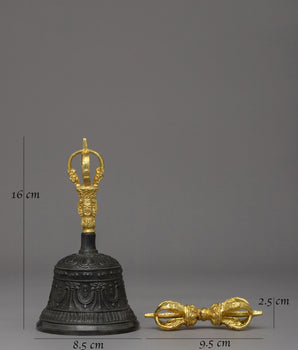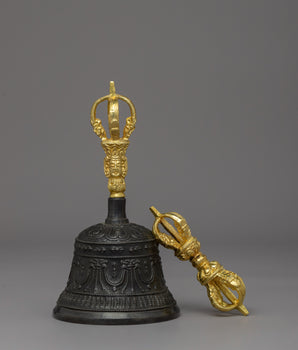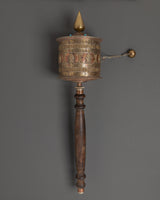

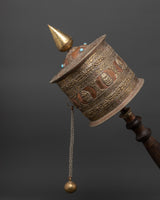
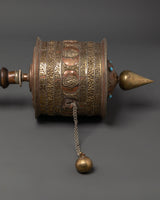
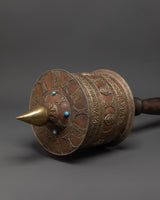
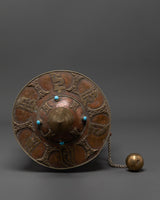
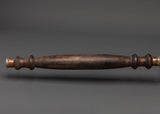
Handcrafted Tibetan Mantra Prayer Wheel | Filigree Copper & Brass Wheel

100% AUTHENTIC

HANDMADE

FREE SHIPPING
Handcrafted Tibetan Mantra Prayer Wheel | Spinning Buddhist Wheel for Altar
--------------------------------------------------------
Size: 88cm(Height) x 22cm (Width)
Weight: 2.41kg
Materials: Brass, Copper Body, Wood
--------------------------------------------------------
About our Prayer Wheel
This Tibetan Mantra Prayer Wheel measures 88 cm tall, 22 cm broad, and 2.41 kg. The drum is made of solid brass and copper and has meticulously carved mantras and auspicious symbols in beautiful filigree work. A polished wood handle adds balance and comfort, while brass caps and elegant finials enhance the wheel's appearance. Each component is expertly built to produce a smooth, rhythmic spin.
Master artists use ancient Tibetan metalworking techniques to create each mantra and deity image in relief. The outside features rows of mantra script, most famously "Om Mani Padme Hum interspersed with lotus blooms and unending knots. Inside, a tightly wrapped roll of mantra-printed paper ensures that each turn brings blessings to the environment. The handle's wooden shaft is hand-turned for comfort, combining form with spiritual function.
This prayer wheel is ideal for home altars, meditation rooms, or temple décor. It encourages ongoing chanting of sacred mantras and enhances spiritual practice. Use it for meditation, blessings, or mindfulness throughout the day.
Introduction to Prayer Wheel
A prayer wheel is cylindrical on a spindle and is used in Tibetan Buddhism. It is typically inscribed with the mantra "Om Mani Padme Hum" and rotated by hand as a form of spiritual practice and to accumulate merit. Spinning the wheel is believed to have the same spiritual benefits as verbally reciting the mantra. The use of prayer wheels is widespread in Tibetan Buddhism and has spread to other cultures.
How does the Buddhist Prayer Wheel benefit us?
The benefits associated with rotating the wheel are numerous. It promotes knowledge, compassion, and bodhicitta in the practitioner and improves siddhis (spiritual powers such as clairvoyance, precognition, etc.). The practitioner can repeat the mantra as often as possible while the wheel is rolling, maintaining a calm, meditative attitude. A Tibetan Buddhist tradition holds that after a practice session, one should dedicate any acquired merits to the benefit of all sentient beings. Then three times Om Ah Hum. This is usually among Tibetans after finishing any Buddhist practice, including the prayer wheel exercise.
How do you set up your own Buddhist Shrine?
• Find a clean, quiet, and uncluttered spot
• Set up an altar table and cover it with an altar cloth that calls to you
• Place your sacred item at the center
















